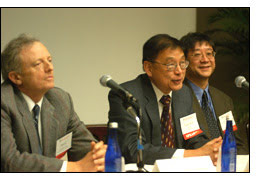TROY, N.Y., Dec. 5 -- Rensselaer Polytechnic Institute (RPI) took another step toward its goal of achieving world-class status as a terahertz research center with the dedication of the W. M. Keck Laboratory for Terahertz Science today.
The Keck laboratory, on the ninth floor of the Low Center for Industrial Innovation, will expand the institute's pioneering work in the development of terahertz science and technology by its Center for Terahertz Research.
Terahertz (THz) radiation, or T-rays -- considered by many to be the energy "wave" of the future -- are in the 100 gigahertz to 10 terahertz range of the electromagnetic spectrum, also known as the far infrared, between microwaves and infrared waves.
TOPIC: TERAHERTZ -- Panelists (left to right) Daniel Gischkowsky, Yuen-Ron Shen and Xi Cheng Zhang. (Photo: Kris Qua, courtesy RPI)
The Keck lab provides powerful new instrumentation -- including a high-resolution THz wave microscope, which offers spectroscopic information not available through other microscopy techniques -- and enables researchers to conduct single-shot, chirped-pulse electron beam measurements, for example, on electron bunches.
Following a tour of the new lab, RPI President Shirley Ann Jackson -- a theoretical physicist by training -- spoke and hosted a panel discussion. Panelists were Xi Cheng Zhang, a science professor at RPI and its THz team leader; Yuen-Ron Shen, a physics professor at the University of California at Berkeley and principal investigator at Lawrence Berkeley National Laboratory; and Daniel Gischkowsky, a professor of optoelectronics in the School of Electrical and Computer Engineering and the Center for Laser and Engineering Photonics Research at Oklahoma State University.
Jackson said the new center is part of RPI's "cultural and intellectual rennaisance" and stressed the need to understand terahertz research and techniques before developing terahertz technology.
"Whatever happens has to be based on fundamental science and a thorough understanding of that fundamental science," she said. "Technology must be based on first-rate research and development."
Grischkowsky agreed: "Long-term research is key to this country. Universities and funding agencies have to protect against pursuing applications too quickly."
Potential terahertz applications include medical imaging, forensic science and food safety. Using a technique pioneered by researchers at RPI, terahertz radiation has already been used to uncover small defects in a sample of space shuttle foam. This nondestructive method could help National Aeronautics and Space Administration officials examine the insulating foam that is applied to each shuttle's fuel tank prior to launch.
RPI researchers were also the first to image biological tissue using single pulses of THz radiation. This single-pulse approach will improve diagnostic time from hours or days, down to minutes or seconds. The technique could one day lead to computerized medical diagnoses right in a doctor's office.
The panelists said commercial THz applications may emerge in three to five years, especially in the areas of homeland security and biomedicine. Potential applications in consumer electronics and nanodevices could take five to 10 years, they said.
For more information, visit: www.rpi.edu